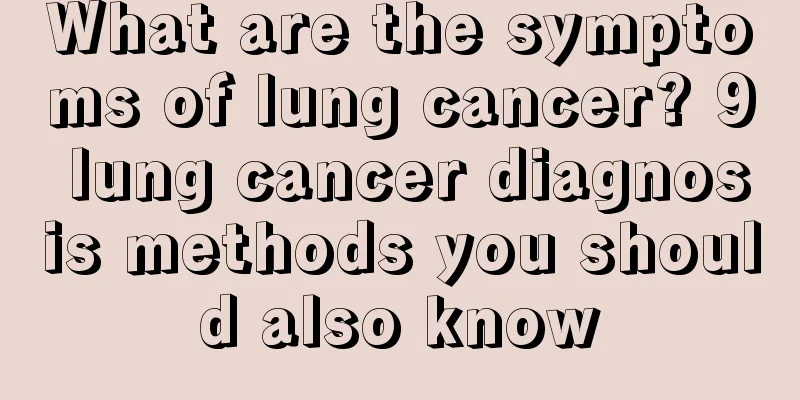What are the symptoms of lung cancer? 9 lung cancer diagnosis methods you should also know

|
The main reason why many people die from lung cancer is that they do not actively receive treatment in the early stages, which results in the metastasis of cancer cells and makes the lung cancer more serious. Therefore, it is recommended that lung cancer patients actively receive treatment after discovering the disease. So what are the symptoms of lung cancer? 1. Early stage lung cancer Early stage lung cancer does not produce obvious symptoms, which may last from a few months to a few years, depending on the individual. At this time, patients rarely seek medical treatment, so it is difficult to detect clinically. Some early symptoms of lung cancer are just general respiratory symptoms such as dry cough, chest pain, low fever, and hemoptysis. These symptoms are confused with colds, bronchitis, pneumonia and other diseases, and it is difficult to attract the attention of patients. 2. Advanced lung cancer Patients with advanced lung cancer often experience symptoms such as weight loss, fatigue, anemia, and fever. When the tumor invades adjacent organs and tissues or metastasizes to distant sites, they may experience symptoms such as shortness of breath, vocal cord paralysis, hoarseness, distended jugular veins, pleural effusion, or difficulty swallowing. 3. Diagnostic methods (1) General condition: This disease should be considered in patients aged 40 years and above, especially men with a long history of smoking, who have an irritating cough for more than 3 weeks that is ineffective after treatment, or blood in the sputum, or repeated attacks of pneumonia in the same part of the body, unexplained limb pain and clubbing, emphysema, atelectasis, dull lung pain, and pleural effusion. (2) X-ray examination: It is an important method for diagnosing lung cancer. In central lung cancer, irregular semicircular shadows can be seen in the hilar region on lung plain films. In peripheral lung cancer, there are nodules with a diameter of 1 to 2 cm or huge blocky shadows of 5 to 6 cm in the lung field on X-ray films. (3) Sputum cytology examination: Exfoliated cancer cells may be found in the sputum coughed up by the patient. (4) Bronchoscopy: For central lung cancer, the tumor at the bronchial opening of the lobe can be directly observed, and pathological examination of the tissue can be performed to confirm the diagnosis. (5) Puncture biopsy: For larger peripheral lung cancers close to the chest wall, the tumor is punctured through the chest wall under X-ray fluoroscopy and tissue is collected for pathological examination. (6) Biopsy of metastatic lesions: For advanced patients with supraclavicular, cervical or axillary lymph node metastases, lymph node metastases can be removed for pathological examination. (7) Radionuclide scanning and CT examination. (8)Immunological examination. (9) Thoracotomy. Through this introduction, everyone should have understood the symptoms of lung cancer at different stages. I hope that friends with lung cancer can pay attention to maintaining good living habits in life. In terms of diet, they should avoid eating fried and puffed foods. In life, they must maintain a good attitude and not show sad and resentful emotions. |
Recommend
What is mycoplasma inflammation?
Mycoplasma is a very common pathogen that general...
Symptoms of lumbar muscle sprain
We all know that the lumbar spine is very fragile...
How many days does it take to eliminate the inflammation of appendicitis abscess
Appendicitis is relatively common in clinical pra...
Tips for preventing prostate cancer
The incidence of prostate cancer is gradually inc...
How to remove resin dental veneers?
Teeth are a very important part of the human body...
What is liquid nitrogen
What is liquid nitrogen? Many people may not know...
What can be checked by taking an X-ray
With the advancement of science and technology, t...
Can anti-inflammatory injections help with lung cancer pain?
The first thing people think about cancer is fear...
Is sandalwood mosquito coil poisonous?
I believe that for many friends, in the hot summe...
What are the nursing methods for thromboangiitis obliterans?
Thromboangiitis obliterans is currently a difficu...
My face becomes red and hot after using facial cleanser
In daily life, facial cleanser is a common face-w...
How to relieve knee pain?
Some patients with rheumatic diseases sometimes f...
How to calibrate a blood glucose meter
With the improvement of people's living stand...
The efficacy and function of white jelly
White jelly is a delicacy we eat in our daily lif...
How to eat leek seeds to improve sexual performance?
Nowadays, many people know that the body is the m...









